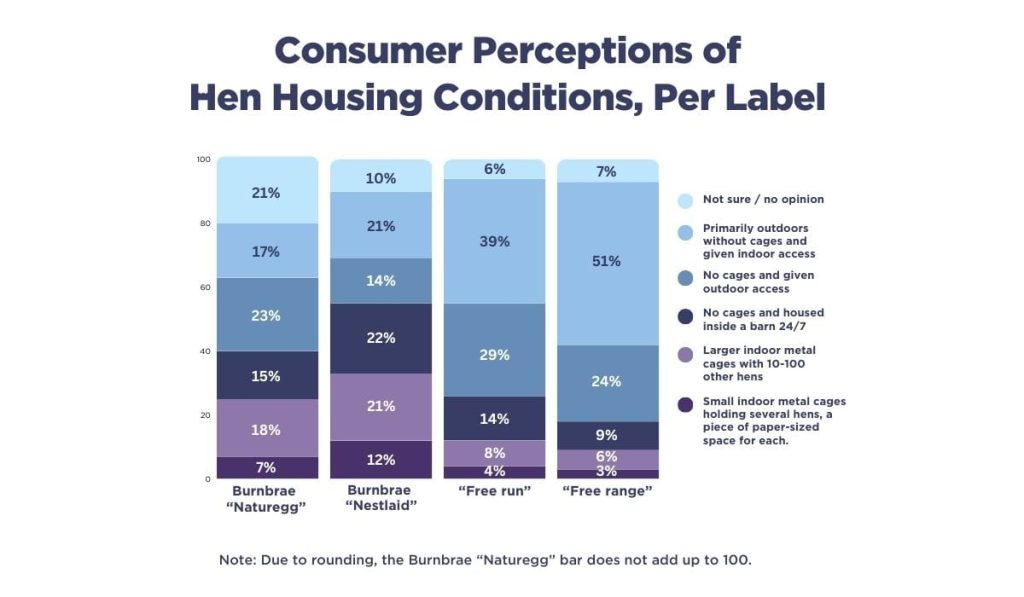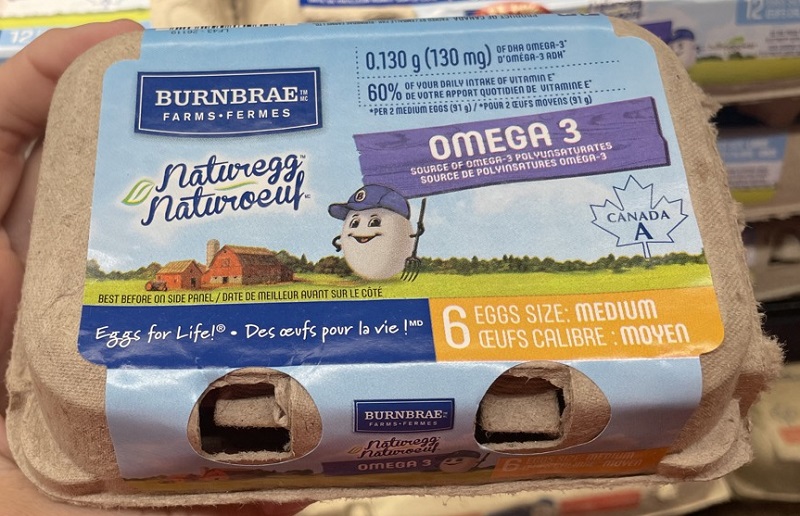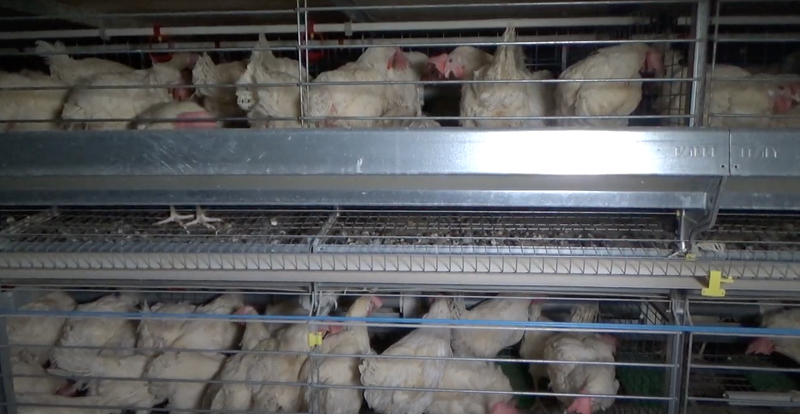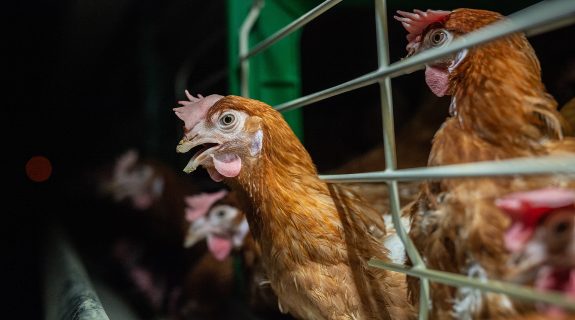This report is prepared by Bryant Research and written by Elise Hankins and Chris Bryant.
The Big Question
Findings From a Survey of 1,006 Canadian Residents Conducted by Bryant Research.
Canadian egg packaging largely misleads consumers on the true state of hens’ welfare, leading to misinformed – and costly – egg- purchasing choices.
This is the key finding of a recent survey of 1,006 Canadian residents conducted by Bryant Research on behalf of Animal Justice.
A large sample of Canadian residents, representative across age, gender, and province, were asked what welfare conditions they think egg-laying hens experience under a variety of labels. This included the brand Burnbrae’s standard “Naturegg” packaging, Burnbrae’s specific “Nestlaid” label, and the general welfare labels “free run” (also known by consumers as “cage-free”) and “free range”. Crucially, respondents were also asked whether they have opted to spend more on these types of eggs, under the impression that such hens experience better welfare.
The vast majority of survey respondents (95%) reported that they purchase eggs. Of these consumers, most (54%) reported that animal welfare influences the eggs they buy, while only a slim minority (7%) felt that the accuracy of welfare labels on egg packaging is not important.
But are welfare labels leading Canadian consumers astray? And is their spending going toward the welfare they expect?
Findings
Housing Conditions
Survey respondents were shown images of common egg packaging and asked what type of housing they believed the corresponding egg-laying hens experience*.
- When prompted with egg brand Burnbrae’s “Naturegg” packaging, only 7% of consumers correctly answered that these hens are held in small indoor metal cages, with each hen provided only the space equivalent to a sheet of paper. These are called “battery cages” or “conventional housing”, and 51.17% of hens in Canada are housed under this system. The majority of consumers (73%) assumed “Naturegg” hens experience some degree of better housing conditions.
- When prompted with Burnbrae’s “Nestlaid” packaging, only 21% of consumers correctly answered that these hens are held in larger indoor metal cages with 10 to 100 hens per cage. Most respondents (57%) believed these hens were housed in better, cageless conditions.
- When shown an additional image of an egg carton proclaiming “enriched colony” housing – the housing system of Burnbrae “Nestlaid” eggs – a mere 11% correctly answered that this term refers to metal cages. The industry in Canada is transitioning away from battery cages. However, it is moving to “enriched cages” – essentially, a larger cage. As of 2022, 31.58% of hens in Canada are in these “enriched cages”, or “enriched colonies”.
- When shown various “free run” packaging examples, only 14% of consumers correctly answered that, while housed in a cageless system, these hens are held indoors 24/7. The majority of consumers (68%) mistakenly believed these hens are housed in better conditions with outdoor space. It is important to note that, though consumers are misinformed about the meaning of the term “free run”, this system does present a marked improvement to caged systems, and several countries and states are banning cages for egg production and moving to cage-free systems. Unfortunately, in Canada, free run covers only 10.84% of hens.

*For each type of packaging (e.g. “Naturegg”, “free run”) throughout this report, we report the subset of respondents who stated that they have purchased the corresponding type of eggs. That is, they are consumers of the relevant eggs.
- After viewing various “free range” packaging examples, only 24% of consumers correctly answered that these hens are housed in a cageless system and granted outdoor access, while most (51%) believed these hens experience better housing conditions – being housed primarily outdoors with indoor access. On paper, free range hens are supposed to have access to the outside, but this is weather-dependent, at the farmer’s discretion, and not subject to inspections or enforcement. In reality, this means that many free range hens in Canada rarely go outside.

- Free-range systems, also used for organic eggs, do provide more opportunities for hens to engage in their natural behaviours and, when managed well, are considered higher welfare systems. However, only 6.42% of hens in Canada are housed in either “free range” or “organic” systems.
These results showcase how misinformed Canadian consumers are about each type of egg they buy.
Example of Burnbrae’s “Naturegg” packaging vs typical housing conditions.


Example of Burnbrae’s “Nestlaid” (“enriched cages”) packaging vs typical housing conditions.


Example of the nests provided in the “Nestlaid” system.

Example of “free-run” packaging vs typical housing conditions.


Purchasing Behaviours
Respondents were asked not only what they thought about the welfare conditions of egg-laying hens but also whether these perceptions have guided their purchasing behaviours. Specifically, consumers were asked if they have opted to spend more on various egg labels, under the impression that the hens experience better welfare.
- Across all egg labels tested, the majority of consumers (52 to 74%) reported that they have deliberately spent more on specific eggs, believing that these labels mean egg-laying hens experience higher welfare.
- While the larger cage systems used under Burnbrae’s “Nestlaid” label do offer some environmental enhancements, they are basically larger battery cages. Still, consumers reported highly inaccurate perceptions of what these welfare conditions entail. Consumers reported misconceptions regarding:
- The “nests” provided in “Nestlaid” systems – only 13% correctly answered that such nests are merely a wire floor surrounded by hanging plastic flaps.
- Additional welfare conditions – the majority of consumers reported that these hens had access to natural light (80%) and outdoor space (74%), could move about freely (76%) and walk on comfortable surfaces rather than metal cage wires (67%), and were not subject to beak trimming (62%) – none of which are accurate.
- Additionally, while “free run” and “free range” labels entail welfare improvements to caged systems, consumers may not have an accurate understanding of the welfare of egg-laying hens when they opt to spend more on these eggs.
- “Free run” hens are not kept in cages, but there is no requirement for them to have outdoor access or natural light. However, consumers reported widespread beliefs that these hens have access to natural light (84%) and the outdoors (83%).
- “Free range” hens are granted some of the highest welfare standards within the egg industry, yet consumers are still misinformed regarding certain practices, such as beak trimming and outdoor access. The majority of respondents reported the mistaken beliefs that “free range” hens are housed primarily outdoors with indoor access (51%) and that they are not subject to beak trimming (79%).

Impact and Recommendations
This survey found that Canadian consumers are guided by animal welfare concerns when choosing their eggs, even when higher welfare means higher price. However, they are widely misled by egg packaging and labels, leading to mistaken beliefs about the welfare conditions that hens experience, and misinformed, costlier purchases.
Regulation of Labels
Canada does not currently regulate claims made by egg companies on packages and labels. There are no legal definitions of terms like “free range” or “enriched colony housing”. Meanwhile, federal authorities have said that addressing concerns over false animal welfare labelling on eggs and other food would be a low priority for the enforcement agency.
To add to the confusion, several private egg certifications schemes have sprung up, which may contribute to “humane-washing” by lending credibility to misleading egg labels. Indeed, industry actors are incentivised to invent certifications to give to themselves in order to add perceived value to their products.
Recommendations for policy:
Consumers deserve clarity. The federal government should introduce legislation to regulate welfare terms on egg cartons, including mandatory standardised labels that make clear to consumers how the hens were housed. A transparent, standardised, and universal welfare label enforced by the government would help ensure that consumers are adequately informed about the reality of the conditions in which hens are housed.
Recommendations for retailers:
Retailers also have a role in ending this widespread consumer confusion. Grocers should post their own signage in the egg cooler and organise eggs by sections to make clear the housing systems used for various brands and labels of eggs.
Signage in Supermarkets
Findings from a previous survey conducted by Bryant Research emphasise the growing consumer demand for transparency and action in animal welfare commitments.
A remarkable 87% of survey participants expressed their desire for retailers to provide clear information about the types of eggs used in their supply chain. Furthermore, an overwhelming 79% of respondents firmly believe that both grocery stores and restaurants should take a stand by completely eliminating cage-sourced eggs from their offerings.
When it comes to communication channels, the survey participants have spoken, with 78% indicating that they prefer to receive information about animal welfare standards through in-store signage. This preference underscores the significant role that in-store signage can play in empowering consumers to make informed choices.
One real-world example of the impact of in-store egg labelling can be seen in Save-On-Foods, which proudly became the first retailer in North America to introduce enhanced egg labelling practices. Their signage clearly distinguishes between eggs produced on cage-free farms and those from battery cages. As a result, Save-On-Foods has witnessed a remarkable shift in consumer behaviour, with cage-free egg sales accounting for over 43% of their total egg sales.
In contrast, Loblaw, the largest retailer in the country, is reporting only 17% cage-free egg sales and has yet to implement in-store communication about their animal welfare commitments. Strikingly, despite the survey revealing that 79% of Loblaw’s consumers support the idea of banning caged eggs and 74% of them expressing a desire for in-store signage about animal welfare commitments, the retailer only recently began reporting its progress in 2023. This highlights how Loblaw is falling behind its competitors and has a huge opportunity to align its practices with the desires of its consumers, and in doing so, potentially witness a positive shift in consumer choices.
In conclusion, the research is clear—consumers are not only seeking transparency but also expect retailers to take action on animal welfare commitments. In-store signage serves as a powerful tool to bridge the gap between consumer expectations and retailer practices, ultimately enabling consumers to make more sustainable and compassionate choices.
Banner: Jo-Anne McArthur | Animal Equality | We Animals Media

